Digital Marketing for Clothing Brands – Online SEO
For businesses and websites that specialize in clothing retail, the strategies for maintaining good business performance are unique. Fashion online marketing means having to appeal to customers across the market with quality products while being able to specialize a digital marketing approach that can help business grow.
There are a few important strategies when it comes to digital marketing for clothing brands.
In addition to the wide range of practices for eCommerce in general, we’ve come up with a few things to keep in mind specifically when it comes to advertising and SEO for clothing brands.
Whether your business needs SEO for your brand’s online clothing store or for your store front as a clothing vendor – there are ways to give yourself an advantage. Clothing often involves product variants where a specific product is sold in alternate styles or colors. Likewise it’s often necessary to have a product show up in multiple categories, which means if you’re not careful you could be hindering your search engine performance with duplicate content issues.
So we’ve set up some guidance on preparing SEO for online clothing stores and best practices to optimize digital marketing for clothing brands.
First of all, why use digital marketing for clothing brands?
Websites that ignore the potential for better organic traffic could be missing out on huge potential business growth in the long term. Data from Statista shows that fashion online marketing accounts for as much as $103 million in the US alone. By 2024 this number could increase to as much as $194 million. By 2018, 57% of global internet users had bought fashion-related products online, making apparel the most popular online shopping category worldwide. Footwear was ranked second with a 47% online purchase reach. This means that as fashion retail shopping trends continue to move into the world of digital, it’s important for brands to stay ahead by keeping up on SEO for apparel.
If you’re looking for more advice to help with selling products, then check out our tips & techniques for eCommerce sites. Or read our tips on fashion SEO:
Canonicalize Multiple Product URLs
This is probably one of the single most important considerations for good SEO for online clothing stores.
For clothing brands and websites, it’s often necessary to have products appear in multiple categories, or to have multiple styles of a single product. This means its generally a good idea to have your products located at one unique, short-style URL. Many businesses choose to have the canonical URL set up as one that branches just off of the domain. For example:
- https://www.example.com/product-url
vs.
- https://www.example.com/mens-category/sub-category/product-url
To be clear, there’s nothing wrong with having your products located in sub-categories to give your shoppers easier navigation (in fact it can be good for SEO on online clothing stores), but if you have multiple URLs for the same product you need to canonicalize them to one central URL.
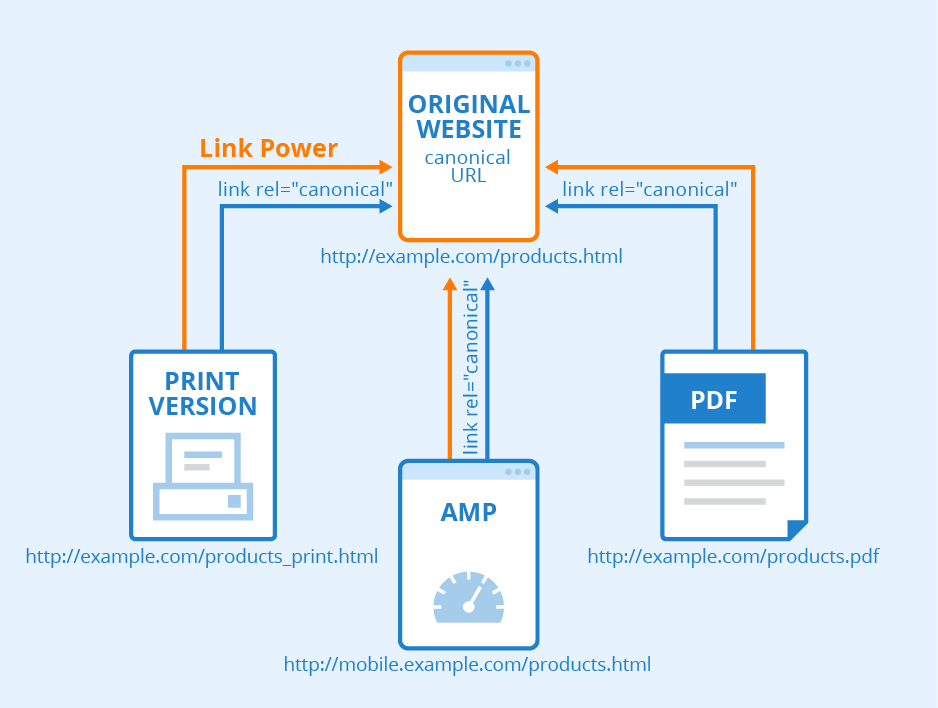
This is important because when Googlebot comes to crawl your site, if it discovers multiple URLs for the same product it won’t know which one is the right one to index.
This should be one of the first steps in SEO for clothing brands since eCommerce sites often require having products listed in multiple categories or in multiple sections of the site. For example you might have a jacket listed in a “Fall Apparel” category and also in a “Men’s Outerwear” category. If this jacket goes on sale, it might even appear in the “Sale” category. Having all of these URLs canonicalized properly is ideal for online clothing store SEO since it can help your site’s crawl budget, improve regular indexing, and reduce duplicate content that can hurt your site.
Target Accurate Keywords that Match Your Audience
This is a basic tenant of SEO, but with digital marketing for clothing brands, keyword strategy can be much more important.
Many websites and online retailers decide to manage their meta title tags and their keyword strategy themselves. But this strategy means being able to keep track of keywords to avoid internally competing or “cannibalizing” your own rankings, it also means being able to perform keyword research to find high-value keywords that actually drive traffic and aren’t too competitive.
An alternative route with digital marketing for clothing brands is to outsource SEO management to an agency. Good SEO services will be able to provide online stores with expert keyword tracking, organic data analytics, site-analysis, and keyword research to make sure their search presence is perfect.
The best approach is to always target longtail keywords that match your products description as closely as possible. For this reason lots of SEO for apparel means targeting “long tail” keywords (search phrases that are generally more specific and usually 4+ words long).
Longtail keywords are ideal because they tend to have a better conversion rate – likely because they represent searchers that have a very good idea of exactly what they want and are ready to buy! The more your product matches that search phrase, the more likely you are to get a sale.
Think about how people typically search for products online and incorporate those habits into your product pages. For example obvious details like gender (men’s, women’s, girl’s, boy’s) can help you broaden your rankings, likewise age (kids, children’s, toddler’s, etc.) can still play a big role in how people shop online.
Be careful with industry jargon and terminology that might be too unfamiliar – you could miss out on more common search language. For example most people don’t search for “neoprene wellingtons,” instead they’ll likely begin their search by looking for something like “waterproof boots.” A good page title might look something like “Waterproof Neoprene Wellington Boots (Brown).”
Similarly, a common mistake in SEO for clothing brands is to stick to color descriptions that are too esoteric. Your product might be “scarlet” or “vermilion” but keep in mind that average shoppers probably won’t go past just searching for “red.”
With our advice above, you might see better results with something like “Women’s Red Waterproof Wellington Boots” then you would with “Scarlet Neoprene Wellingtons.”
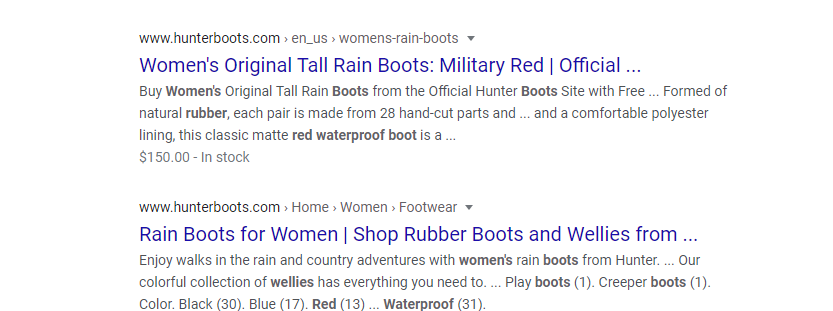
Canonicalizing Your Product Variants
We already talked above about canonicalizing URLs for products that are shared across multiple categories. But what about multiple product pages for product variants? It turns out this is one of the most important considerations when doing SEO for apparel.
For example if you have a product that is available in multiple colors should you have them all listed under one URL, with a filter/selection for each color via a URL string? Or Should you list them as separate products completely, on separate URLs?
For example:
- www.example.com/mens-t-shirt?variant=blue VS. www.example.com/mens-t-shirt?variant=green (Here they are one canonical URL with color variants as URL strings)
- www.example.com/mens-t-shirt-blue VS. www.example.com/mens-t-shirt-green (Here they are each separate URLs)
So which is best? It depends.
For something like color, there may be enough interest on different color types where it makes sense to have each product listed separately (and of course have your meta title tags, and page titles reflect the color differences accordingly). But for other more minute differences in your product, it might not make sense to do this (you’ll just end up with too many URLs clogging your site with none of them doing well in SEO).
Ask yourself what’s best for your shoppers and target-customers before deciding how to set up product variants for your store. Digital marketing for clothing brands means understanding your target keywords and customer shopping habits and setting up your pages accordingly – good practice is to set up unique individual URLs for variables that you know can perform on their own (gender, color, fit) and to canonicalize variants into one main URL for less important or less concrete variables (size, trim, price, genre, and in some cases materials).
Intuitive Categories and Site Structure
Site structure is also an important element in SEO for online clothing stores/brands. Search engines like Google and Bing crawl your site with bots to learn its hierarchy and to find URLs to index.
Digital marketing for clothing brands will hinge on which broad types of products are most important, and which are not. Think broadly about what types of clothing you will offer and drill down from there. Understand the most important variables your customers will consider when beginning their online shopping at the start of the search funnel (by product type, gender, preferred brand, etc.) – then create category pages that cater to these needs. This will be a key starting point for clothing brand digital marketing.
Site structure usually consists of your top-level pages (nav-bar categories), sub-catagories, and product pages. Best practice with SEO for online clothing stores is to place your most important broad/high-value keywords on your top-level pages. Then place your lower-value/long-tail keywords onto sub-categories (as long as they’re accurate!). The more intuitive your site’s design, the better your SEO results when search engine bots crawl your site.
Related Products
Many clothing brands and online stores opt to include “related products” suggestions on parts of their websites. This is a classic strategy in digital marketing for clothing since it can improve user experience while also encouraging CTR to other pages, improving time-on-site, and helping with the potential for an online conversion. Variations on this strategy include:
- Shoppers also bought
- Items commonly bought together
- Recently viewed
- Best selling items
Plus, it’s also good practice as part of SEO for online clothing stores. It does so by helping Googlebot and Bingbot crawl your site more easily to keep your indexing status healthy. As search engines crawl your site, they go from page-to-page gathering data, if they find links to other pages they’ll crawl those too, and the more frequently they can do this, the more frequently your site will be updated in the search results.
It can also help with important business KPIs by decreasing bounce-rate, growing session length, or increasing pages-per-session.
Submit Your Sitemap in Search Console
Another way to improve indexing is to give Google easier access to your sitemap.
Creating a sitemap means that your products will be discovered more easily and will enter into Google search results more quickly – it’s also a step that’s actively encouraged by Google. Set up or go into your site’s Search Console account and submit your site map in the appropriate section.
Make sure that your clothing store’s sitemap only includes status code 200 URLs – there should be no redirects, 404s, or non-canonical URLs (separate URLs for the same pages). Digital marketing for clothing brands means utilizing good SEO technical skills for better brand visibility – sitemaps are important here.
Healthy eCommerce sites can set up their sitemap to ensure that no matter what, searchers are always finding up-to-date, and in-stock products.
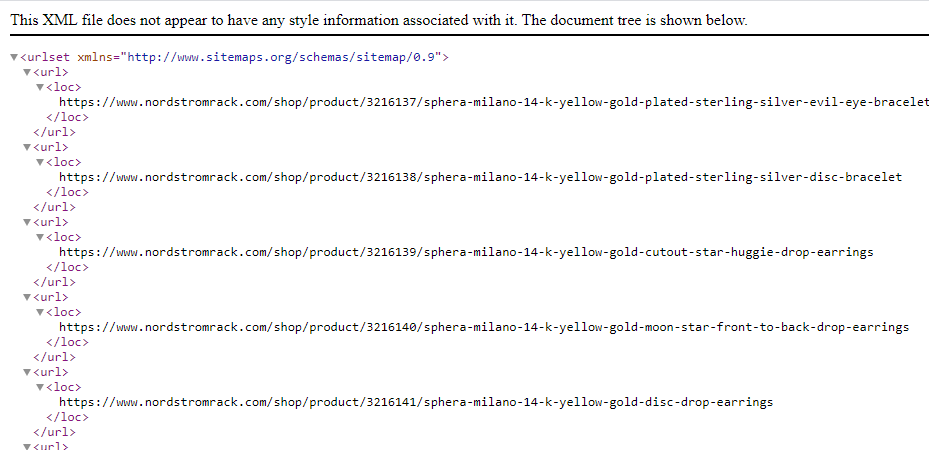
Structured Data
Although it’s not a ranking factor on Google or Bing, structured data (also called schema markup) is a good way of boosting SEO for clothing brands and retailers. Web developers and marketers with online clothing stores should work to implement good structured data markup on their site to improve their SERP visibility.
Structured data ads product data and helpful details to your listings in the search results – including product pricing, buyer ratings, inventory status, and more! Details that are important for clothing shoppers.
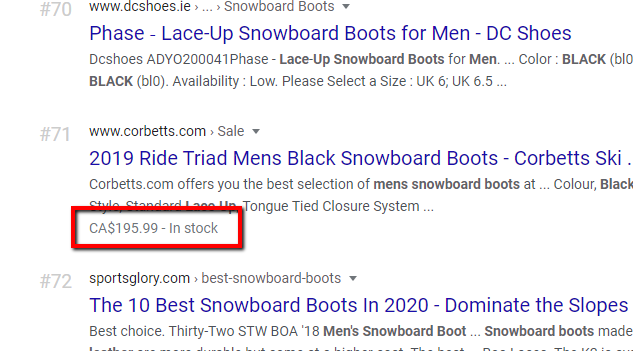
The most common types of structured data include JSON-LD, Microdata, and RDFa – each feature different kinds of markup, but give the same results by adding extra detail to Google and Bing result snippets.
The schema organization even provides product specific markup guidance specifically designed to help with digital marketing for clothing brands and fashion online marketing. In fact schema can also help incorporate SEO for online clothing stores with local properties for brick-and-mortar locations as well. The schema.org site gives businesses guidance one what sort of properties they can use, including:
- OpeningHours
- paymentAccepted
- aggregateRating
- brand
- color
- SKU
- Weight
- Width
- Plus a lot more…
Structured data is a good resource for clothing stores trying to get an edge on organic traffic performance or to capitalize on existing rankings by improving click-through-rate for their products. This means that product pages with structured data can get more site-traffic for long-tail, purchase-intent-driven keywords.
Google Shopping Free Listings
This is a relatively new evolution in SEO that clothing stores and brands would do well to capitalize on. Google’s Shopping service is a separate tab in the Google family of search products that used to only feature paid product ads but has now opened up to include free organic product listings.
This is a huge opportunity and could be an important digital marketing strategy for clothing brands that want to extent their reach beyond marketplaces like Amazon, Walmart, AliExpress, etc. Google Shopping organic now gives a whole new approach for apparel and fashion SEO by allowing businesses to sell their product directly from the Google results page.
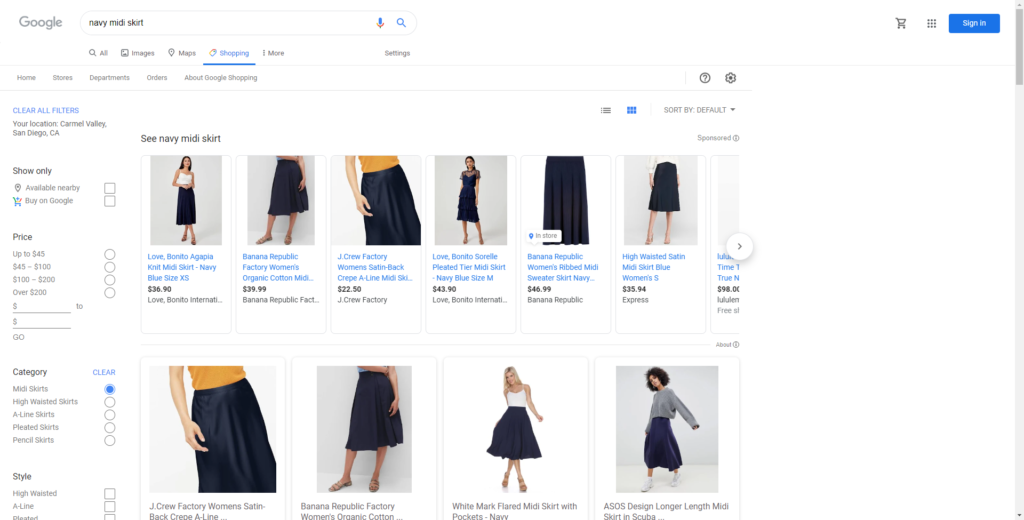
Normally called Product Listing Ads (PLAs) these listings have to be uploaded using a Google Merchant Center account. With this free account marketers can upload their products (with required product info) to Merchant Center and have it set to appear on Surfaces Across Google. This is the same process that’s required for pay-per-click advertising (PPC) via Google Shopping, but now marketers can follow the steps for uploading their inventory to Merchant Center and have their products display for free – the paid ads are only an additional optional step.
Why use Google Shopping SEO for clothing brands?
35% of Google product searches turn into transactions within 5 days, and 2018 saw ad spend on Google Shopping increase the fastest it had in 2 years. As the channel continues to expand into organic it will give benefits like these to SEO focused brands as well. It will likely continue to provide even more revenue opportunities for eCommerce and fashion brands looking to exploit Google’s 5.6 billion daily searches.
Blogs for Inbound Traffic
One of the most difficult business goals for clothing brands is being able to drive traffic on a more massive scale. The reason being that SEO digital marketing for clothing brands often relies on traffic to product pages while also trying to expand visibility as a whole.
Top-level pages, important categories, and nav-bar pages face a highly competitive world of high-traffic keywords and often struggle to get rankings. Categories for keywords like “Kid’s jackets,” or “High-top shoes” are so broad that Google and Bing are virtually flooded with thousands of global competitors vying for page 1 rankings.
In order to get your site’s top-level pages to rank, you need what’s known in the SEO world as domain authority – a term used to describe the inscrutable SEO value of a domain as judged by Google and Bing’s complex algorithms. One of the best ways to get domain authority is with high-value inbound links, from other websites. The more high-quality inbound links you receive the better you will perform.
So what does this mean in SEO for online clothing stores?
Link building is a difficult and risky venture – the only real way to get links is to let them grow naturally. So most brands have turned to blogs and content marketing to help improve their clothing store SEO. High-quality blogs can help naturally encourage back-link growth to your domain over time, as well as encourage inbound traffic for customers interested in your brand. For even better results, blog-posts should be built on expertise, authority, and trust (or EAT in the SEO world).
With core algorithm updates in August of 2019 along with updates to its Search Quality Evaluator Guidelines Google has begun to emphasize the important of EAT for websites. Though there’s no distinct way of measuring EAT, or any source that proves it’s a specific ranking factor, there is evidence to suggest that EAT can help improve SEO in general.
Think about how your blogs can target intent driven keyword traffic as well as establish your expertise and authority in your area of business. Focus on company history, up-to-date Contact/About pages, and well-researched, or detailed content that provides users with the information they want.
Demonstrating your expertise while expanding your SEO rankings through blogs is a good way to grow your business long term and improve ROI. Blogs that rank well can help channel traffic to products on your site and lead to increase sales and better SEO for your clothing brand.
Learn More
Contact our representatives for information on digital marketing for clothing brands and professional SEO for apparel. Get a free site consultation and learn how professional SEO service can help your brand grow.
